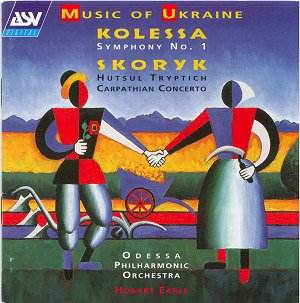MYKOLA KOLESSA (b
1903)
Symphony No. 1 (1950) 33
mins
MYROSLAV SKORYK (b.1938)
Hutsul Triptych (1965)
Carpathian Concerto
(1972)
 Odessa PO/Hobart Earle
Odessa PO/Hobart Earle
rec Odessa, 7-10 July 1994
 ASV CD DCA 963
[66.29]
ASV CD DCA 963
[66.29]
Amazon
UK

Kolessa writes flowingly and with a kindly Tchaikovskian grace (Third Suite).
The 'pay-off' to the big tune of the first movement suggests (an unlikely)
acquaintance with Vaughan Williams' Sixth Symphony. The second movement's
allegro vivace has much in common with Korngold's care-free Robin Hood music
(and indeed the symphony). Into this stream flows the tense expectancy of
Beethoven 5 and 7 and some sunlit Delian moments (3.10). The Largo basks
amid blue skies and cuckoo calls - an idyll of the heights - complete with
horn solo in authentic 'warbling' style. This has a touch of Szymanowski's
Harnasie about it. In the festive finale Kolessa celebrates with the best.
Borodin is the model. I thought this symphony well worth while and something
you will want to return to. Don't let the Soviet Realist movement titles
distract you from enjoying a joyous piece of musicmaking. Let's have the
Second Symphony now!
Skoryk's Hutsul Triptych is drawn from music for Paradzhanov's film 'Shadows
of Forgotten Ancestors'. Panel 1 is swift, lively, folksy and of a type one
can imagine Carmen Dragon taking up. Ivan and Marichka is a dream dance woven
around the mystery of The Firebird and the Alan Hovhaness's simpler utterances.
Ivan's Death has barbarous elements and strange sounds linking with the
symphonies of Avet Terteryan.
The Carpathian Concerto has a folk 'skirl' comparable to a Scottish 'snap'
and a yearning lyrical line typical of Constant Lambert in Summer's Last
Will and Music for Orchestra. The cimbalom is cross-cut with the wildness
of Grainger's Warriors. The woodwind are brilliantly active and a little
dance suggests the opening and finale of Walter Piston's Symphony No. 2.
The horns are splendidly blatant. As the Concerto closes the sentimental
'Highlands' theme is treated (none too gently) to the avant-garde process
and the cimbalom puts in a welcome appearance.
Whether it is in the gorgeous (almost Hungarian) barbarity of Skoryk or radiance
of Kolessa turn to this disc for reassurance that there are new and satisfying
things that can be done with the orchestra. It delivers an excitement given
to very few CDs.
Is it too much to hope that ASV will return to Odessa to record the Second
Symphony of Kolessa and some more Skoryk (there are two each concertos for
violin and for piano and a cello concerto)?
Rob Barnett

